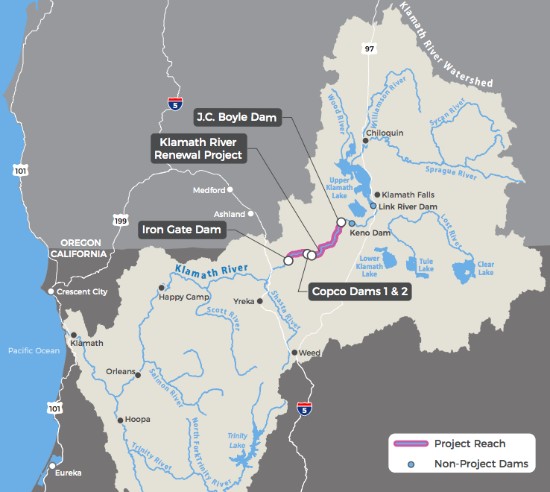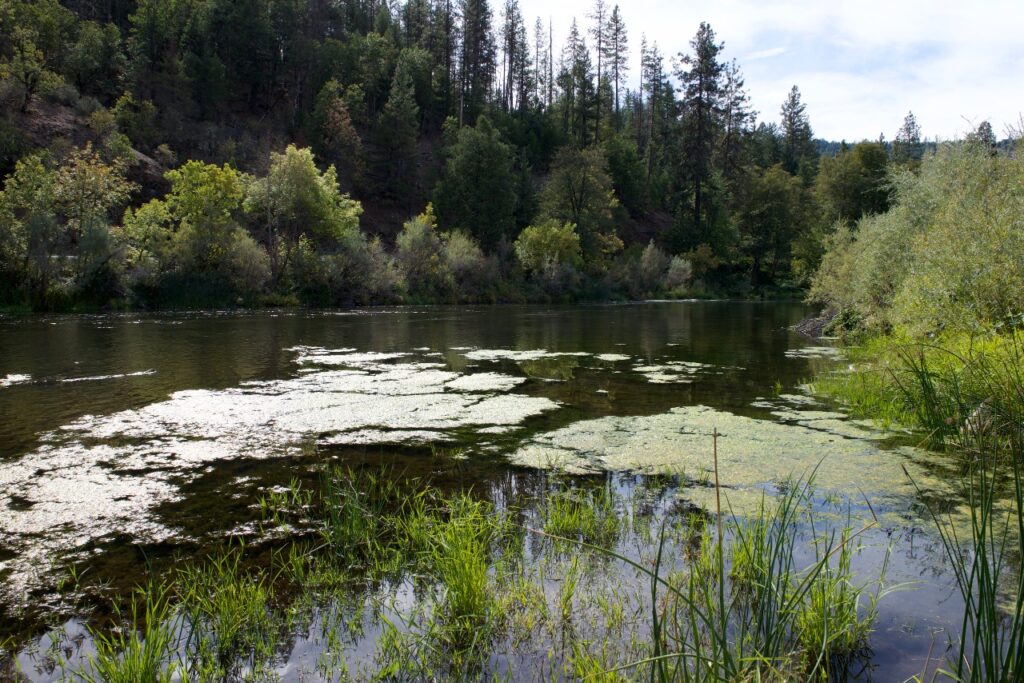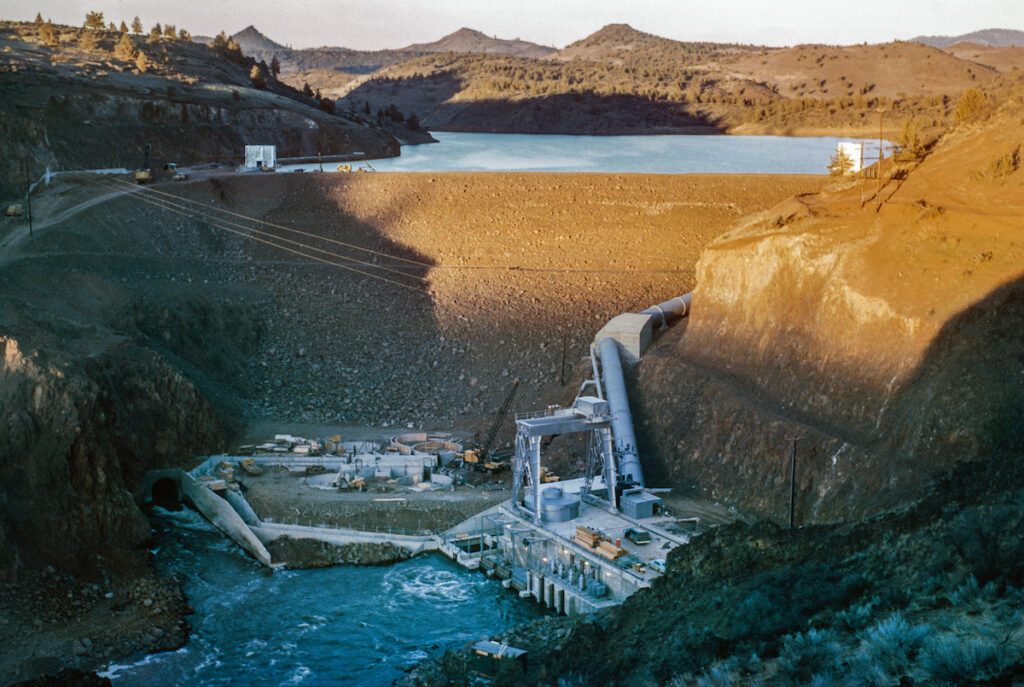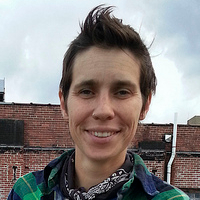Next year will be the big year. By the end of 2024 the Lower Klamath River will run free for the first time in a century, enabling fish like salmon and steelhead to reclaim 400 miles of river habitat in California and Oregon.
The removal of four dams on the river — the largest dam-removal and river-restoration project to date — got the official go-ahead late last year after two decades of work from the region’s Tribes and other advocates.
But before next year’s much-anticipated demolitions begin, a lot remains to be done.
The smallest of the four dams, Copco 2, will come down in 2023, and crews will improve roads and bridges, move a municipal water line, and build a new fish hatchery.

PHOTO: The Klamath River watershed and the four dams slated for removal. (Map by Klamath River Renewal Corporation)
Proponents expect dam removal to help resuscitate a beleaguered river where dams have blocked migratory fish and warm reservoir waters have spurred toxic algae growth and fed deadly fish parasites. But evaluating the ecosystem after dam removal — and understanding how to manage a changing river — requires a firm understanding of how all the river’s components function today.
To accomplish that, researchers have spent years gathering information on everything from salmon to algae to bats. And now, as they enter the critical final year, they’re hustling to collect as much data as they can before the dams finally come down.
“It’s an exciting time for the river because dam removal has been a long time coming,” says Laurel Genzoli, a researcher from the University of Montana who has been studying algae and water quality on the Klamath. “But it’s also a stressful time, because this is the last summer to collect data with the dams in place, and we have to make sure we have everything we think we might need.”
Long-Term Data
The uphill political battle to remove the dams began two decades ago. But the effort only started gaining widespread support in the past few years. Thankfully researchers have been studying the river for a longer time, amassing comprehensive data that could form the baselines for future comparisons.
Many of these researchers are affiliated with universities, or state and federal agencies, and some are from the region’s Tribes. Upstream are the Klamath Tribes in Oregon. And along the lower Klamath River in California are the Yurok, Karuk, Hoopa Valley, Quartz Valley Indian Community and the Resighini Rancheria.
“We’ve been monitoring fish populations for decades — how many fish are spawning, how many are being captured, how many juvenile fish are out-migrating,” says Barry McCovey Jr., a fisheries biologist from the Yurok Tribe. “As far as salmon populations go, we’ve been tracking that closely for a long time.”
Recovering salmon populations for Tribes’ cultural and subsistence needs, and for the health of the ecosystem, is a key goal for river restoration.
Tribes have also been involved in more than a decade of research in partnership with state agencies, the U.S. Fish and Wildlife Service, and researchers from the Oregon State University to track the fish disease Ceratanova shasta, a parasite that’s decimated salmon populations.
That work began independent of dam removal, but it’s become increasingly important because researchers expect a free-flowing river will help reduce the deadly parasite.
The same is true for water quality, which Tribes have tracked for years.
“That work didn’t begin because of dam removal, but the baseline data will be helpful afterwards,” says Genzoli, who works with Tribes from the lower Klamath River to gather data on water quality.
She’s also studying the growth of algae and other aquatic plants. Driven in part by a large amount of upstream nutrients, the river produces a lot of algae. Too much can clog fishing nets, and some can be toxic, endangering wildlife and human health.

Algae on the Klamath River. Photo: Tara Lohan
Robert Lusardi, a research scientist at the University of California, Davis and a fish scientist for the nonprofit California Trout, is working with the Yurok Tribe and others to study the aquatic invertebrates which feed on those plants, as well as water temperature and chemistry. “Those are really good indicators of change in the system,” says Lusardi.
That baseline data will be important. “When the dams come down, we’ll start doing this same work in the river that’s currently under the reservoirs and it will help us evaluate how the river and tributaries are recovering,” says McCovey.
Moving up the food chain, another group of researchers is studying an animal that often feeds on aquatic insects — bats.
Barbara Clucas, an associate professor in the Department of Wildlife at Cal Poly Humboldt, works with her graduate student Ryan Matilton and other researchers to collect baseline data on the species of bats in the region and their activity levels.
As the diversity or abundance of invertebrates change after dam removal, so might their predators.
“I would imagine that dam removal would change bats’ prey base,” says Clucas. “That could impact when and where we see them. It’s possible that looking at how their diversity, abundance or activity levels change could give an indication of the health of the system overall.”
Dam-Removal Research
While some long-term monitoring will be useful for post-dam study, other efforts have been initiated specifically for dam removal.
One of those is extensive research and mapping by the U.S. Geological Survey of how sediment will move, and what effect that could have on streamside vegetation and the downstream estuary.
Other work has targeted fish — a main conservation priority.
Lusardi has been studying where salmon go in the basin, including the mainstem of the Klamath and its tributaries, by examining fish ear bones — or otoliths. The researchers began by measuring how much of the element strontium was present in the water in different parts of the basin. Most tributaries have very distinct strontium signatures.
“When juvenile salmon rear in the basin, depending on where they are, they’re picking up these strontium signatures in their ear bones,” he explains. “When they come back as adults and they spawn and die, we pull the carcasses out of the river, remove their otoliths, and send them to the lab to be analyzed.” Based on the strontium values, they can learn where the juveniles spent their time.
Working with the Fish and Wildlife Service and the Yurok Tribe, they’ve spent two years collecting otoliths.
“This will provide a baseline of understanding how fish use the basin below the dams now,” he says. After the dams come out, they’ll be able to track returning fish to understand how they’re moving back into the longer reach of the river and tributaries they couldn’t reach before.
Lusardi is also involved in another project with the Oregon Department of Fish and Wildlife, the Klamath Tribes, the National Marine Fishery Service, the National Oceanic and Atmospheric Administration, and the California Department of Fish and Wildlife to better understand how spring-run Chinook will use the basin.
Once numerous throughout the watershed, these native fish are now limited to only one tributary below the dams. Last year the researchers released 1,500 acoustically tagged juveniles above the dams by Upper Klamath Lake and have followed how and when they’re out-migrating. They’re set to do another release this spring.

The earth-filled hydroelectric Iron Gate Dam, powerhouse and spillway on the lower Klamtha River near Hornbrook, Calif. in 1962. Photo: D.L. Christensen / California Department of Water Resources
“We’ve got a really good idea of when they were leaving the tributaries, when they’re moving into Upper Klamath Lake, and how quickly they’re moving through the lake,” he says. “It’s giving us a really good idea of how spring-run Chinook might use the basin [after dam removal] and should be really useful for adaptively managing them in the future.”
Science, People and Decisions
Another area of study enabled by funding from Oregon Sea Grant pairs university researchers from Oregon State University with University of Montana’s Genzoli and the Yurok Tribe to look at how dam removal will affect water quality, the aquatic food web, and water use by the diverse groups that live in the basin.
“We’re partnering with the Yurok Tribe to expand our knowledge about the river and about how decisions can be more equitable,” says project leader Desiree Tullos, a professor of river engineering at Oregon State University.
There are three parts to the project. The first is understanding the connections between water quality and the food web, which can create good or bad habitat for fish, aquatic plants and toxic algae.
Second is the people part. They’re working with stakeholders in the basin, including Tribal members, landowners, ranchers, irrigators and environmental advocates to inform decision making about managing water quality with an eye toward equity.
That scientific and social research will then inform the third part of the project — decision modeling.
“We’re going to bring all those data on the people and the ecosystem together and run a bunch of computer simulations,” she says. That might include looking at how recreation or opportunities for Tribes could change if water quality is managed in a different way.
Models can tell them “if we restore 1,000 acres of wetland in the upper basin, would that get us to a place where there’s no longer toxic algal blooms, or do we need 10,000 acres of wetland?” she says. “And then how does that change if there’s more droughts or more wildfires in the future? Or how does it change if we use a decision process that the Tribe follows, or a local NGO, or the Bureau of Reclamation?”
Funding Issues
All of this research is just a sampling of what’s being undertaken on the river. And while much of it is done in collaboration, there’s no overarching entity — or fund — responsible for overseeing pre-dam removal study.
Last year an op-ed from two well-known experts, fish scientist Peter Moyle and geomorphologist Jeffrey Mount, lamented as much.
“Although more than $450 million has been allocated for the dam removal, to our knowledge, little has been allocated to fund the science needed to evaluate it,” they wrote. “This is a mistake.”
Despite that, researchers have found money from disparate sources — government agencies, universities, nonprofits, private foundations. And they’ve established their own working groups and conferences to share information and drive further collaboration.
“People are sticking with it and dedicated to continuing to do what we can to try to collect data and understand how these changes are affecting the river,” says Genzoli. But she admits that some bigger picture connections could be missed between areas of specialty.
Making sure the science is funded, “is the most important thing,” says Lusardi. “Not just to document what’s happening, but to adaptably manage the river [after dam removal] too.”
Tribal Leadership
While researchers may lack a central — and robust — monetary fund, they do have another valuable resource that’s helped deepen their understanding of the river: Tribes.

Klamath Basin Tribes and allies rally in 2006 for dam removal. Photo: Patrick McCully, (CC BY 2.0)
“Tribal members were essential in driving the politics of dam removal forward, but they have also been maintaining long-term water quality, fisheries and wildlife records of this river in a way we don’t see on most rivers,” says Genzoli.
And it’s not just the western scientific data Tribes have collected, but their traditional knowledge of the ecosystem.
“Tribes have been on the landscape since time immemorial,” says Tullos. “They can tell us things about what a wet versus a dry year is that don’t rely on discharge measurements, but on their observations of where the river was or how bad the algae was in that year. We can get these really full data sets by piling on what we, western scientists measure, with what Indigenous folks understand about the system. By bringing together these multiple ways of knowing, that gives us a much richer understanding.”
And that can help drive an ambitious goal.
“A lot of people would say that this is just a huge fish-restoration project and it’s going to really be great for salmon,” says McCovey. “But for me, it’s so much more than that.”
It’s in their culture as Yurok people to restore balance to the world and ecosystem, he says. To be “people who fix the world.”
“The act of removing those dams and restoring that energy flow from the upper basin to the lower basin is an act of our cultural identity,” he says. “From a Tribal perspective, we are helping to restore that balance, and in a small way, we’re helping to fix the world.”
![]()






